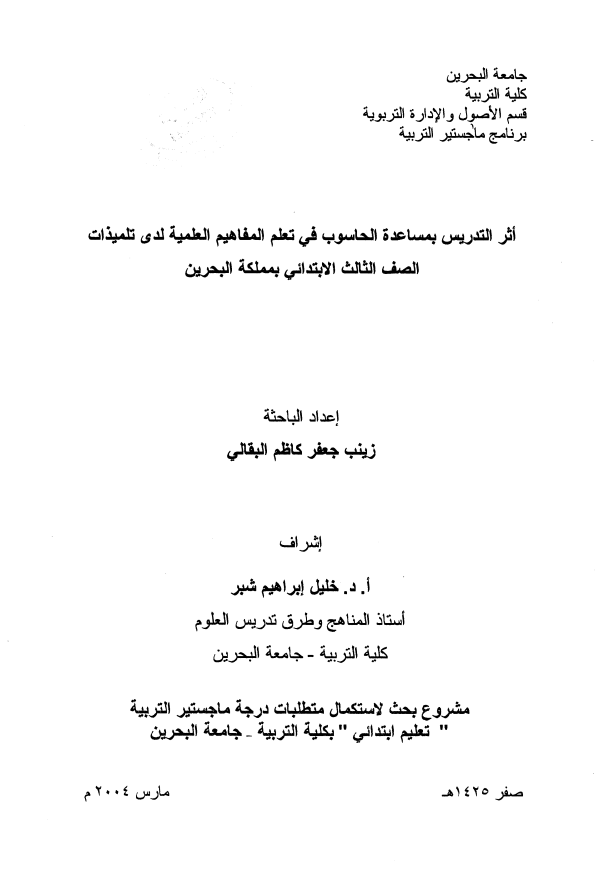وثيقة
واقع تكامل تكنولوجيا المعلومات والاتصال مع المنهج في المدارس الابتدائية من وجهة نظر المعلمين والمديرين والاختصاصيين التربويين
وكيل مرتبط
القمص، سمير إيليا , مشرف الرسالة العلمية
تاريخ النشر
2012
اللغة
العربية
مدى
[1], 1, [1], 5, 121, [5]
الموضوع
مكان المؤسسة
Sakhir, Bahrain
نوع الرسالة الجامعية
Thesis {Master}
الجهه المانحه
University of Bahrain, College of Education, Department of Curriculum and Methods of Teaching
الملخص الإنجليزي
Abstract:
This study was aimed to investigate the actual reality of information and communication technology (ICT) in terms of the level of their integration to the current school curriculum in the primary stage. The study attempted to explore this from the point of views of the teachers, school principals and educational specialists at the elementary stage. Three major questions were developed. They were:
(1) What is the basic standards for the integration of information and communication technology with the curriculum?
(2) What the reality of the application of these standards in primary schools from the perspective of teachers, principles, and education specialists?
(3) What the difficulties facing the application of these standards and what are the solutions proposed for the successful implementation of the curriculum with the integration of information and communication technology from the perspective of teachers, principles and education specialists?
To answer these questions, the researcher designed a questionnaire and implemented it on a sample of (184) teachers in the core subjects, principles of primary schools and a number of educational specialists in the primary education sector. data were analyzed through calculating the percentages, mean and standard deviation of the responses obtained from the participants. The findings of the study revealed that there are three major standards that should be available to obtain full integration between the ICT and formal curriculum in the school. In addition, the study showed that the arithmetic mean of the first axis that is associated with the availability of information and communication technology in the school and the reality of use is 3.15 and the arithmetic average of its indicators ranges between (2.42 to 3.92). The third finding shows that the arithmetic mean of the second axis of the reality of the application of policies
and procedures for school integration in any medium degree is 2.84, and the ranging value of the arithmetic average of the indices is between (2.51 to 3.03). The third axis of the contributions of the integration of information and communication technology in primary school curriculum was weak as it reached the level of 2.48 and the average indices ranges between (1.98 to 2.65) due to poor implementation and application to employ the technology in its integration with the curriculum. In the same regard, the data also showed that the that there are difficulties facing the application of integration of the curriculum and information and communication technology. This was the answer for question three and it showed that some cases, such as lack of devices and suitable programs, the incompatibility of current curriculum the integration process, and the need for training and the existence of a clear vision were all factors that played role in this reality.
As an action, the study proposed some recommendation to improve the actual reality of integrating ICT with the current school curriculum. First, in-service training for teachers to practice the profession on how to implement the integration should be accomplished. In addition definite actions should be done to identify the technological problems faced by each teacher and then restrict the plan of workshops to overcome them. The study also provided a comprehensive plan consisting of three stages to achieve integration of ICT with curriculum.
Finally, the study implies an implementation of standards of integration found in this study, and an issuance of legislation and policies that support the integration process and the follow-up applications. It also recommends a development of a phased plan to implement the integration processes in the school curriculum and a follow-up implementation as these all are believed to activate the role of the project of His Majesty King Hamad future schools to ensure the actual application of the standards of integration, referred to in the study.
ملاحظة
عنوان الغلاف:
REALITY OF INTEGRATING INFORMATION AND COMMUNICATION TECHNOLOGY WITHIN THE PRIMARY SCHOOL CURRICULUM FROM THE VIEWPOINT OF THE TEACHERS, SCHOOL PRINCIPALS AND EDUCATIONAL SPECIALISTS
REALITY OF INTEGRATING INFORMATION AND COMMUNICATION TECHNOLOGY WITHIN THE PRIMARY SCHOOL CURRICULUM FROM THE VIEWPOINT OF THE TEACHERS, SCHOOL PRINCIPALS AND EDUCATIONAL SPECIALISTS
المجموعة
المعرف
https://digitalrepository.uob.edu.bh/id/44fcfbc3-2f4a-4b79-8843-fe3ece506273
مواد أخرى لنفس الموضوع
